What is Mourning Jewelry - From the Georgian Era to Modern Mourning
My name is death, cannot you see?
Lords, dukes, and ladies bow down to me.
And you are one of those branches three,
And you fair maid, and you fair maid,
And you fair maid must come with me.
- 16th Century English Ballad, "Death and the Lady"

Whether rich, poor, old or young, death is something we all hold in common. It often comes unexpectedly, and for those of us still living, leaves a hole in our heart and in our lives. For many cultures, art has offered a way to explore one's relationship with death and process the grief more openly. In Europe and the United States, the 18th century saw a renaissance of this through intricate and beautiful mourning jewelry. Before we talk about modern mourning jewelry, let's dive into the history.
The History of Mourning Jewelry - from Memento Mori to Public Grieving

In the dark Middle Ages, death was seen in a sinister light - a judgement of God that often included suffering (the "sinner's death") and invoked fear and horror. One's life ended in what was perceived as a preordained manner, and people died young. Up through the 17th century, "Memento Mori" jewelry was common - macabre pieces with skulls, skeletons and other figures which stood as a reminder of one's own imminent death.
By the 18th century, several ideologies began to shift in Western culture which laid the foundation for more outward expressions of grief over loved ones lost. The enlightenment - the Age of Reason - brought forth a new perspective on death. Not only was science taking center stage, but a new humanist philosophy of self-improvement, self-rule and equality began to take root. In the latter part of the 18th century the Romantic movement took hold; death was seen as a reintegration with the natural world (dust to dust) and was sentimentalized in art and poetry alike. The Memento Mori mindset gave way to one that was more outwardly focused on the death of the "other."
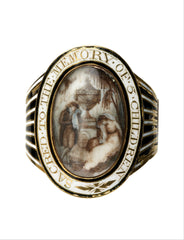
This softened view of death laid fertile ground for the beautiful imagery often seen on mourning jewelry, including the weeping willows, angels, forget-me-not flowers and the birds in flight. Alongside this, the growing prosperity across classes enabled an increasing number of people to afford tombstones, burials and mourning jewelry. One could even build it into their funeral plans that rings would be made for their family.
Mourning jewelry took root in the Georgian era - early 1700's to the 1830's - when the execution of King Charles I of England led many royalists to show their sympathies by wearing faceted Stuart crystal pieces (the King was in the house of Stuart) with the King's likeness underneath. A trend took hold - wealthy aristocrats began to have their own mourning pieces commissioned when they lost loved ones. However, it was the death of Queen Victoria's beloved Albert that started the mourning jewelry craze, as Victoria memorialized Albert in various ways up through her own death. She wore her mourning ring the rest of her life.
What is Mourning Jewelry and Why Was it Created?
"It is often said that something may survive of a person after his death, if that person was an artist and put a little of himself into his work. It is perhaps in the same way that a sort of cutting taken from one person and grafted on to the heart of another continues to carry on its existence even when the person from whom it had been detached has perished."
- Marcel Proust, Remembrance of Things Past
Despite the ascent of science in the age of Enlightenment, death by war and illness plagued most families. The loss of children was expected (often the reason for having large families to begin with), and in burgeoning cities such as Manchester disease spread rapidly and many did not live past the age of 17. Many women died in childbirth, and historians have estimated that upwards of 1/3rd of Victorian children died before the age of 10.
The expression of "those who have gone before" was something heard often in the Victorian era; Victorians accepted that death was at the doorstep at all times, and thus mourning art became a way to discuss and acknowledge this reality, albeit in a subtle way that fit the more strict Victorian codes of behavior. Art in all forms, including jewelry, became a way to demonstrate the belief and trust in eternal life and a reuniting with beloveds in the future. It was also a way to remember a loved one in the time before photography was common.
In short, mourning jewelry was and is a ring, brooch, bracelet, cuff links or other type of jewel which memorializes loved ones lost. Georgian and Victorian mourning jewelry came in many forms:
- Using hair from the deceased in an art scene or as a simple or braided lock of hair incorporated into the design of the piece.

- Hand done enamel work in varying colors, namely black and white. The enamel often contrasted with names and dates of the deceased
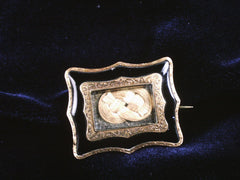
- Imagery done in sepia on ivory. Often these images were elaborate and poetic, with women weeping at tombstones, weeping willow trees blowing in the wind, urns with inscriptions and symbols, and angels or birds.

- Incorporating colors and materials which told the story of the life lost - pearls often represented a child lost, black agate, onyx, jet, obsidian, vulcanite and hematite were popular choices to symbolize grief, and white enamel represented an unwed, virginal woman. Not all black jewelry was mourning jewelry, however, since black was an overall popular fashion choice with women and men at the time. Diamonds were a rarity in Victorian mourning jewelry, although they were occasionally used.
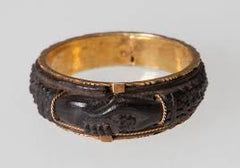
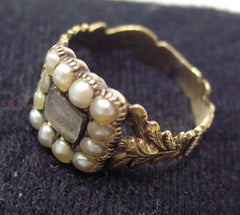
- Inscriptions of "not lost but gone before," "we must submit" and "in memory of" were hand engraved or incorporated into the design of the piece.
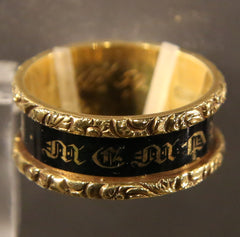
- Earlier in the Victorian period when clothing was bulkier, larger brooches were common, as were mourning rings. As women's clothing shifted to expose necklines, necklaces became more common and brooches became smaller.

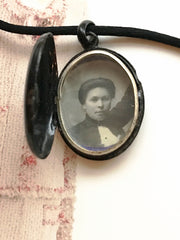
- As photography became a medium available to the masses, small photographs also began to be incorporated into memorial pieces.
The Stages of Grief - According to the Victorians
In modern times Kubler-Ross's "five stages of grief" has become what we know of how we process the death of a loved one; denial, anger, bargaining, depression and acceptance are the stages we are told we move through over the course of grieving. Sometimes you'll even see two additional stages of grief added to this, shock and guilt.
The Victorians embraced stages of grieving on a societal level, and the stages were often a visible trend in fashion and jewelry.
Deepest Mourning
Historically, the first stage of grief was called deepest mourning, and this was the time immediately following a death. For a widower, this stage would last a year and a day. It was felt that reflections - a portal into the soul - should be avoided during this phase of grieving, with mirrors, photographs and portraits turned around and reflections avoided. With jewelry this resulted in matte finishes and non-reflective surfaces, although in the early Victorian period women were often expected to remain unadorned and wear no jewelry during this stage.
Second/Ordinary Stages of Grief
During this stage of grief, historically only black and white gems were allowed. Pearls were popular, as was white and black enamel. This stage allowed for fancier fabrics, black velvet and silk, lace, fringe and ribbons.
Third/Half Stages of Grief
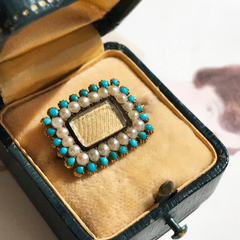
After twenty-one months, additional adornment was allowed within grieving. Gentlemen could change their buttons from black to silver, women could wear some ordinary clothing, and jewelry expanded to allow diamonds, gold and silver pieces, and colors such as mauve (which could be achieved through gemstones like amethyst). Turquoise and other gems could be used if done tactfully and in a way that honored the continued mourning. This stage of grief would often go on for the duration of someone's life, as was the case with Queen Victoria.
However, the expected length of mourning as it related to fashion and etiquette often depended on your relationship to the deceased person. Widows stayed in mourning for two years, whereas those grieving a child or parents publicly grieved for one year, grandparents and siblings six months, aunts and uncles a few months, and a continued shortened stage of grieving as your familial relationship with the person grew more distant.
Modern and Contemporary Mourning Jewelry
While the Victorians get the credit for popularizing mourning jewelry, and of course the trend has never seen such glory days since, modern and contemporary mourning pieces are gaining in popularity more recently. Particularly in an age where personal stories are paramount and people are sharing more and more of their personal journeys publicly, mourning jewelry offers a way to wear your story.

At Stacey Fay Designs, we have a growing line of mourning pieces to offer comfort and connection to those who are grieving, from pieces with enamel, to those with hair and ash or other sentimental objects. From "there is a light that never goes out" rings and keepsake pendants, to the new cremation ring or the many custom pieces we've done for other types of loss including miscarriage and divorce. Whether through our Memoir Jewelry line, available for order, or through your own one-of-a-kind piece you design with us, each design allows you to hold your story and your grief close, and to honor it in the way it deserves.
What do you think of mourning jewelry, would you wear it? Let us know in a comment below.
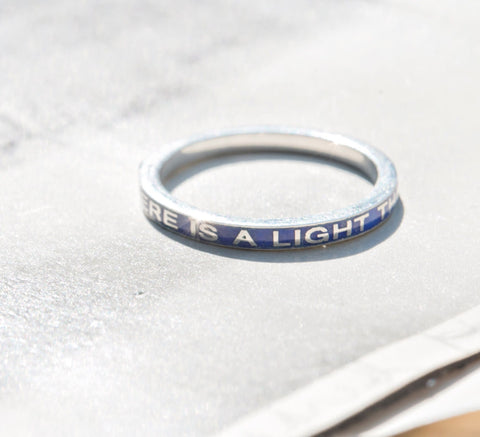
Research credits for this piece belong largely to the book Mourning Art & Jewelry by Maureen DeLorme as well as the incredible Art of Mourning blog.
2 comments
I have been looking at mourning jewelry for probably ten years in hopes of finding a piece that would convey to people that I was in mourning without being specific to one episode of grief. Nothing large but a tasteful piece. I feel it would allow people to appreciate your grief without you having to tell people directly. Not wanting something with hair or skulls. I would definitely wear it.
Hi Iam a 2nd yr BA Applied Arts student, and my dissertation is going to be on mourning jewlery. Did you get a good response from modern day wearing of mourning jewlery? I really would appreciate any information or insights into you finds really helpful.
Your faithfully
Helen Murphy
